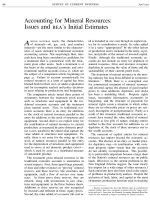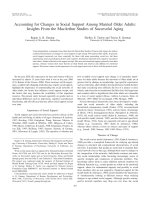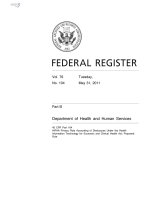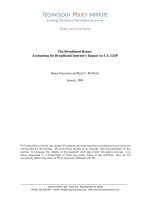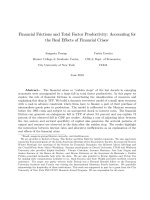The Broadband Bonus: Accounting for Broadband Internet’s Impact on U.S. GDP potx
Bạn đang xem bản rút gọn của tài liệu. Xem và tải ngay bản đầy đủ của tài liệu tại đây (872.73 KB, 64 trang )
!"#!$%&%$'()%%(*$+,$
!
$' (%$/#/$
!
$,0'1.+2(3+*$45$6###/$
713+%8$6#69:6:9""#/$
!
$%;<0.=8$>?@ABCDEFGAH>EI>?JC>CKCD9ALM$
!
$,%N8$OOO9CDEFGAH>EI>?JC>CKCD9ALM$
$
PUBLICATION OF NOTE
$
$
The Broadband Bonus:
Accounting for Broadband Internet’s Impact on U.S. GDP
Shane Greenstein and Ryan C. McDevitt
January, 2009
$
$
$
$
$
$
$
$
$
$
TPI Publications of Note are studies TPI believes provide important contributions but were not
conducted by TPI scholars. TPI posts these studies on its website, with the permission of the
authors, to increase the visibility of the research and help inform the policy process. Any
views expressed in a Publication of Note are solely those of the author(s), and do not
necessarily reflect the views of TPI or anybody affiliated with TPI.
$
The Broadband Bonus:
Accounting for Broadband Internet’s Impact on U.S.
GDP
Shane Greenstein and Ryan C. McDevitt
!
January, 2009.
Comments welcome.
!
We are affiliated with Kellogg School of Management and Department of Economics, Northwestern
University, respectively. We thank David Burstein, Greg Crawford, Ken Flamm, Barbara Fraumeni, John
Horrigan, Chuck Jackson, Scott Savage, Alicia Shems, Dan Sichel, Ali Yurukoglu,
and Philip Webre for
useful conversations. We thank the Searle Foundation and the Kaufman Foundation for funding. All errors
are our responsibility.
1
Abstract
How much economic value did the diffusion of broadband create? We provide
benchmark estimates for 1999 to 2006. We observe $39 billion of total revenue in
Internet access in 2006, with broadband accounting for $28 billion of this total.
Depending on the estimate, households generated $20 to $22 billion of the broadband
revenue. Approximately $8.3 to $10.6 billion was additional revenue created between
1999 and 2006. That replacement is associated with $4.8 to $6.7 billion in consumer
surplus, which is not measured via Gross Domestic Product (GDP). An Internet-access
Consumer Price Index (CPI) would have to decline by 1.6% to 2.2% per year for it to
reflect the creation of value. These estimates both differ substantially from those typically
quoted in Washington policy discussions, and they shed light on several broadband
policy issues, such as why relying on private investment worked to diffuse broadband in
many US urban locations at the start of the millennium.
2
I. Introduction
In September 2001, approximately 45 million US households accessed the Internet
through a dial-up connection, while only 10 million used a broadband connection.
1
By
March 2006, a sharply contrasting picture emerged: Approximately 47 million
households (and growing) had broadband connections, while 34 million (and declining)
used dial-up.
2
The economic determinants behind this trend are straightforward: Dial-up became
available first and diffused to more than half of US households. Broadband emerged later
as a higher quality and more expensive alternative, albeit one available in only a few
places and from a limited set of providers, if any. Then over time, broadband became
more reliable and more widely available, and as that happened, many households paid to
upgrade their Internet service.
The upgrade to broadband motivates a seemingly straightforward question: What
was the contribution to new economic value created through the replacement of dial-up
access with broadband? This type of question has appeared in prior literature measuring
new goods, and prior work has developed two conventional approaches: One focuses on
the creation of new economic growth, as measured by new gross domestic product
(GDP), and the other focuses on new consumer surplus. Neither economic yardstick is
better than the other, because each measures something different.
1
NTIA (2004) is the source for these statistics.
2
See Horrigan (2007) at
3
Addressing this topic is not solely of academic interest but also informs long-
standing policy interest in deployment of the “last mile,” that is, the supply of services for
delivering data between the national/global data grid and end-users. In recent times the
revenue associated with the last mile was quite large. In fact, Internet access revenue
measurements reached $39 billion in 2006. For some time, there has been debate about
the structure for maximizing the economic gains from building this infrastructure.
3
Most
of the literature does not examine but instead assumes that the infrastructure led to
large economic gains. In contrast, this paper examines the potential for the
(mis)measurement of those gains.
Here, we calculate a benchmark for the two conventional approaches to
measuring economic gains. We render these numerical estimates in the spirit of Johnson,
who states, “That, sir, is the good of counting. It brings every thing to a certainty, which
before floated in the mind indefinitely.”
4
In other words, we provide numerical estimates
where before there had been none. This establishes the plausible range of the size of the
measured economic gains from the upgrade to broadband.
Our findings are as follows: While broadband accounted for $28 billion of GDP
in 2006 (out of $39 billion in total for Internet access), we estimate that approximately
$20 to $22 billion was associated with household use. Of that amount we estimate that
broadband’s deployment created approximately $8.3 to $10.6 billion of new GDP. In
3
The policy concern arises from the belief that this infrastructure plays a key role in fostering
others, and from international ranking showing that the United States has lower deployment than many
other developed countries. See
/>, e.g., OECD
Broadband Portal. For an interpretation and discussion of issues, see Atkinson, Correa, and Hedlund
(2008).
4
From Boswell’s Life of Johnson.
4
addition, between $6.7 and $4.8 billion is new consumer surplus. In both cases, this is
above and beyond what dial-up would have generated. The newly created GDP is
between 40% and 50% of measured total GDP, while consumer surplus (which is not
measured) is between 31% and 47% of the newly created GDP. We can express the latter
gain as an equivalent decline in prices. We show that Internet access price indices would
have to decline 1.6% to 2.2% per year to account for the consumer benefits generated
from upgrading to broadband.
Our estimates are interesting for a number of reasons. First, they are much lower
than those typically quoted by Washington-based policy analysts and lobbyists, who
regularly quote outsized economic benefits from the deployment of broadband in the
range of hundreds of billions of dollars.
5
We believe our estimates suggest that these
outsized estimates are dangerously misleading at best and are rendered with flawed
economic reasoning and incorrect statistical approaches.
6
Second, our estimate also differs from the CPI (Consumer Price Index) for
Internet access. We correct a historically inaccurate inference about the pricing of
Internet access and conclude that the official index’s timing of price decline is actually
several years too late.
5
Crandall and Jackson (2001) analysis is a typical example, emphasizing indirect benefits with a
title that discusses a “$500 Billion dollar opportunity.” Crandall (2005) cites the same study and others,
pegging the gains at $300 billion. More recently, Connected Nation (2008) pegs the benefits from national
deployment of broadband in only rural areas at $134 Billion. For a summary of these and other studies, see
Atkinson, Correa, and Hedlund (2008).
6
For example, the report by Connected Nation (2008) uses estimates of the growth brought about
by broadband in urban areas to estimate its impact in rural areas. Such estimates do not control for
endogeneity or the projecting of results to ranges of data far out of sample. The report also adds additional
benefits to broadband by focusing on the “indirect” benefits from deployment of broadband. The language
of “direct and indirect” benefits obscures the boundary between private willingness to pay and externalities,
as found in conventional economic approaches.
5
Third, our second conclusion leads to another implication: We inform
understanding about why the national policy of the last decade has had the effects it did.
Initially, most federal policy sought to subsidize the deployment of dial-up technologies
to less-served areas and users
7
; but, at the outset of the millennium, policy changed.
8
The
new policies relied largely on the private incentives of private actors to deploy broadband
technologies, without subsidy or any regulatory intervention. In retrospect, they seemed
to work well—that is, broadband diffused widely. Yet, this outcome was puzzling in light
of the lack of price change measured in the CPI. In fact, our findings resolve this puzzle:
Price indices undervalued the gains to users, and these gains were what motivated the
upgrade at many households. In addition, our recalculation of conventional GDP
estimates illustrates that the incremental gain to a broadband supplier from creating new
revenue covered the costs of investments in urban and suburban areas. In short, there was
no policy magic to relying on private incentives. Private benefits simply exceeded private
costs if both are measured correctly.
As emphasized by Fogel (1962), Bresnahan and Gordon (1997), and many others,
neither yardstick for economic gains is easy to measure in ways consistent with standard
7
In the early 1990s, US national policy focused on deploying technologies that allowed for higher
data-transfer rates over telephone lines, such as ISDN (Integrated Service Date Networks), which supported
bandwidth speeds of 128k. Later, changes to access and interconnection policies altered investment
incentives for incumbent local exchange providers. For example, the e-rate program was a provision of the
1996 Telecommunication Act and sought to subsidize the cost of deploying dial-up access for hard-to-serve
areas. Later still, the FCC (Federal Communications Commission) reclassified broadband investment
outside the range of procedures used to review common carriers, raising incentives for such investment. For
an overview, see Goldstein (2005), Neuchterlein and Weiser (2005) and Greenstein (2008).
8
It is no exaggeration to say that policy was shaped by events, such as the implosion of
competitive local exchange competitors (the so-called “Telecom meltdown”), the AOL/Time Warner
merger, the dot-com bubble burst, and Worldcom’s and Enron’s bankruptcies. So too did the effects of the
administration change on the legal interplay between the FCC and courts reviewing its decisions. For an
overview, see, e.g., Goldstein (2005), Neuchterlein and Weiser (2005) and Greenstein (2008).
6
economic foundations. Rendering benchmarks requires accurate data on prices and
quantities for household use of the Internet, and these must be interpreted through an
appropriate model. While we do not present any statistical advances in this paper, we do
illustrate the importance of using well-known economic methods for an on-going policy
debate, particularly where such methods are regularly overlooked. Assembling the best
publicly available sources of data is also another of this paper’s contributions. A third
contribution is the calibration exercise we perform using different assumptions consistent
with the available data. That exercise exposes the importance of specific assumptions and
focuses attention on areas that require improvement and more precision. In that sense, our
study is in line with the sentiments expressed by Flamm and colleagues (2007),9 who
argue for putting US broadband policy on a footing more firmly founded in conventional
economic reasoning and transparent statistic approaches.
Our plan is as follows: In Section II, we briefly discuss our approach to measuring
the economic value generated by broadband. In Section III, we measure the diffusion and
pricing of Internet access services during the years between 1999 and 2006 in relation to
the GDP and CPI. In Section IV, we discuss the data we collect; and in Section V, we
perform our simulations of the value created by the diffusion of broadband. Finally, in
Section VI, we conclude with an assessment of future directions for policy discussions.
9
Flamm, Friedlander, Horrigan, and Lehr (2007) focuses on a wide range of issues, such as
measuring productivity and assembling new data to accommodate novel on-line economic behavior. The
primary goal of this paper is to dig deeply into one aspect of this broad agenda.
7
II. The Measurement of Economic Benefits from New
Goods
There is an established literature for measuring the economic gains from the deployment
of a new good. It has been widely accepted since Fogel (1962) that it is an error to focus
solely on the demand for and supply of the new good. Instead, attention should be paid to
the additional benefits beyond what would have occurred without the deployment of the
new good. Fogel famously illustrated this concept by measuring the contribution of
railroads to economic growth in the United States in the mid-Nineteenth Century, while
stressing the economic growth above and beyond what canals would have provided had
they continued to operate. In this paper, there is an analogous measurement—between the
deployment of broadband and what would have occurred had dial-up continued to operate
at a large scale.
Here, we measure two gains from the new good by addressing two questions:
First, what is the increase in revenue (GDP) above and beyond what would have been
generated had dial-up continued? Second, what is the increase in consumer surplus
beyond what would have occurred had dial-up continued? When doing these exercises we
will follow convention and not worry about which vendor or user gains or loses, but will
only compute an aggregate measure.
We focus on revenue instead of producer surplus because we are hampered by the
lack of precise information about the unit cost of provision, which is necessary for an
estimate of producer surplus at each point in time. Rather, we examine the difference in
revenue between vendors with broadband and those without, absent multiplier and
8
general equilibrium effects. That is, we estimate how much the GDP increased in the
Internet access market as a result of the deployment of broadband. Then, to provide a
ballpark of the producer surplus generated, we compare that estimate against estimates
for upgrade costs and delivery costs.
To measure consumer surplus ideally, we should measure the difference in “areas
under the demand curves” between the actual demand for broadband and what consumer
surplus would have demanded had dial-up continued and not been replaced by
broadband. This is challenging to do for many reasons, but two are primary here: (1)
Existing broadband markets do not have the type of variance in price that helps identify
demand with precision. (2) We cannot observe what the dial-up market would have
looked like had broadband not diffused. Instead of measuring two demand curves, we get
close to our ideal measure by looking at estimates of user willingness to pay for the
upgrade to broadband.
Our approaches provide a more precise interpretation of the economic gains from
broadband in comparison to the approach commonly employed in policy discussions
today, which focuses on “indirect/direct” benefits from the upgrade.
10
Here, we measure
the economic factors considered by parties involved in a transaction—anything that
shapes the perceived or anticipated costs of using dial-up, the willingness to pay for an
upgrade to broadband, and/or the decision not to return to dial-up. The following factors
shape revenue for suppliers: Sale of second lines, revenue for dial-up access, and revenue
for broadband access. The following factors shape the anticipated value of broadband
10
Such reasoning can be found throughout policy discussion about the economic benefits from
diffusion of broadband. See e.g., Atkinson, Correa, and Hedlund (2008) for a summary.
9
service and, hence, the willingness to pay for an upgrade: Savings on a second line,
savings on commute time, anticipated health and entertainment benefits, and anticipated
savings on phone bill (e.g., if user moves to VoIP, or Voice-Over Internet Protocol).
Our understanding of these factors circumscribes our interpretation of the
estimates, which do not include externalities, such as benefits or costs not considered by
the parties involved in the transaction. For example, our interpretation does not include
externalities to suppliers, such as the benefits to Cisco from selling more Wi-Fi
equipment to users, to Amazon from additional sales because broadband users experience
more satisfying service, or to Google from more advertisement sales because users stay
on-line longer. Similarly, our interpretation does not include externalities to users. Those
would be unanticipated or unperceived costs or gains—such as the unanticipated
slowness that one neighbor’s use imposes on another’s in a cable architecture, or the
benefits that one person’s participation in a p2p (peer-to-peer) network confers on
another (as long as there is no membership fee).
II. i. Gaps in Measurement
While our exercise follows the spirit of Fogel (1962), we recognize the criticism that
technical change in a key nationwide infrastructure motivates an endogenous response in
complementary goods and services (see, e.g., David 1969). This alternative approach
would argue that had broadband never diffused, many of the complementary services
(e.g., downloadable music, video sharing) might not have been invented, or alternative
innovations might have dominated an industry where dial-up had primacy, thereby
altering the demand for dial-up. In this alternative view, the Fogel-exercise is mis-
10
specified when these complementary services have great the economic significance, and
that invariably occurs as time passes.
We avoid addressing such debates for two reasons. First, we focus on such a short
time period (eight years), and our data will show that most US households have
comparatively little experience with using on-line broadband. Second, most surveys of
on-line household use after the upgrades show only mild changes in the time and
composition of activity on-line. These changes are not symptoms of radical short-term
transformations in economic outcomes, as would occur if the entry of complementary
services were economically important to the economic gains realized by users.
11
The approach in this paper will lead to much smaller estimates of the economic
benefits from the diffusion of broadband than found in existing policy studies. This arises
for several reasons: First, as noted, we follow the spirit of Fogel's research and others
have not.
12
Second, this study does not count any indirect benefits. In our reading of other
studies, it appears that the presence of indirect benefits has been license for analysts to
blur the boundary between internalized benefits and externalities in economic growth. At
worse, analysts have added many benefits to the deployment of broadband far out of
scale with the private benefits motivating adoption.
13
Third, we calibrate against the
actual diffusion pattern of broadband over eight years, not any forecast of an ideal year or
11
Surveys show that the greatest changes in behavior among new users of broadband occur in
music downloading and total time on-line, not in the general distribution of time spent among different
categories of activities other than music. See e.g.,
12
For example, Crandall and Jackson (2001) calculate the entire area under the demand curve for
broadband, but they should have subtracted a substantial part of that because much of that consumer
surplus would have arisen with dial-up anyway.
13
See, e.g., Connected Nation (2008) for an especially egregious example of misuse of this
license.
11
adoption pattern. Calibrating against history (instead of a forecast) grounds estimates and
removes considerable hype.
III. Measuring Broadband Services
III.i. Internet Deployment Policy
To familiarize readers with this technology and market, we provide a picture of
deployment, adoption, and revenue generation for broadband. All these data tell a similar
story. The diffusion of dial-up coincided with the initial use of the Internet in most
households. The diffusion of broadband came a few years later and, most commonly,
involved an upgrade of the bandwidth for many households.
For all intents and purposes, during this period, broadband service was delivered
to households primarily in two forms—over cable or telephone lines. The former
involved a gradual upgrade to cable plants in many locales, depending on the generation
of the cable system.
14
The latter involved upgrades to telephone switches and lines to
make it feasible to deliver a service called Digital Subscriber Line (DSL). Both of these
typically supported higher bandwidth to the household than from it—called Asymmetric
Digital Subscriber Line (ADSL) in the latter case. Some cable firms built out their
facilities to deliver these services in the late 1990s, and many—especially telephone
companies—waited until the early to mid 2000s.
14
In many areas, households also had access to direct supply of high-speed lines, such as T-1
lines. This was prohibitively expensive for almost all users except businesses, and even then, it was mostly
used by businesses in dense urban areas, where the fiber was cheaper to lay. Fiber to the home has recently
become cheaper, and may become a viable option sometime in the future. See Crandall (2005). During the
1990s most cable companies sold access to the line directly to users, but made arrangements with other
firms, such as Roadrunner or @home, to handle traffic, routing, management and other facets of the user
experience. Some of these arrangements changed after 2001, either due to managerial preferences, as when
@home lost its contract, or due to regulatory mandates to give users choice over another Internet Service
Provider (ISP), as occurred after the AOL/Time Warner merger. See Rosston (2006).
12
Broadband has several appealing features that users experience in heterogeneous
ways. In comparison to dial-up service, broadband provides households with faster
Internet access and better on-line applications. In addition, broadband services are also
“always on,” and users perceive that as a more convenient service.
15
Broadband also may
allow users to avoid an additional phone line for supporting dial-up. That said, many
factors shape the quality of a user’s experience, such as the capacity/bandwidth of lines,
the number of users in the neighborhood in a cable system, the geographic location of a
system in the national grid, the frequency of use of sites with geographically dispersed
caching, and the time of day at which the household performs most activities. In brief,
generalizations are hard to make beyond the obvious: Broadband gives the user a better
experience than dial-up access.
16
III.ii. Measuring Diffusion
Broadband was available in only a few locations in the 1990s and the early 2000s, but it
became more available over time. User demands for high-bandwidth applications
increased as households became familiar with high-bandwidth Internet applications (such
as music downloading). Firms also rolled out new services as more users acquired
broadband (e.g., Web2.0 applications), which then generated even more adoption.
15
Surveys show that a maximum rate of 14.4K (kilobytes per second) and 28.8K were
predominant in the mid 1990s for dial-up modems. The typical bandwidth in the late 1990s was 43K to
51K, with a maximum of 56K. DSL and cable achieved much higher maximum bandwidths, typically
somewhere in the neighborhood of a maximum rate of 750K to 3M (megabytes per second), depending on
the user choices and vendor configuration.
16
Download speed may not reach the advertised maxima. In cable networks, for example,
congestion issues were possible during peak hours. In DSL networks, the quality of service could decline
significantly for users far away from the central switch. The results are difficult to measure with precision.
13
This story is consistent with Figure 1, which provides a summary of the federal
government’s efforts to collect data about the adoption of the Internet.
17
The first
questions about broadband use appear in 2000 and show a growth in adoption, peaking at
close to 20% of households in 2003, when these surveys were discontinued for some
time.
18
Recent data about household use, collected by the Pew Internet and American
Life Project, show that the diffusion continued in the anticipated direction, accelerating
somewhat.
19
Notably, adoption reached over 47% of households by 2006. We will
discuss this data in more detail below. In Table 1, we provide a summary of another set
of efforts by the FCC to measure the deployment of broadband lines, information that the
17
The first government surveys of household Internet adoption date back to 1997. These came
from additional questions in the CPS Supplement, which had added questions about household use of
personal computers in 1995. See NTIA (1995). These were continued with surveys in 1997, 1998, 2000,
2001, and 2003. See NTIA (2004). The survey was stopped after 2003, then reinitiated in 2007. The latest
data are not available, as of this writing.
18
The descriptive results were published in reports authored by staff at the NTIA. See NTIA
(2004).
19
See
14
FCC collects from surveys of firms.
20
It tells the same story as Figure 1, but from the
vendor-side of the market: Vendors were increasingly deploying broadband lines,
presumably to meet growing household demand.
TABLE 1 Residential broadband deployment, 1000s of households
!! !! ! !
Year 1999 2000 2001 2002 2003 2004 2005 2006
DSL
291.8 1594.9 3616.0 5529.2 8909.0 13119.3 17371.1 20143.3
Cable
1402.4 3294.5 7050.7 1342.5 16416.4 21270.2 24690.0 27720.4
Satellite
50.2 102.4 195.0 257.0 341.9 422.6 529.4 1839.4
Source: Federal Communications Commission.
21
There are no revenue estimates for household broadband services, but we can
place a bound on an estimate for the combination of household and business revenues.
The US Bureau of the Census estimates revenues and publishes these in its Annual
Service Survey. Table 2 provides a summary of these reports, to which we have made
considerable adjustments to correct for related measurement issues. (See Appendix).
22
We expect that between 60% and 80% of the revenue in Table 2 is from households,
depending on the year and access mode.
23
20
The FCC has never asked about deployment of dial-up. It also has never asked about the prices
of broadband.
21
See Broadband Reports, Table 3.
22
The adjustments are for changes in sampling frame; Census does not return to historical
estimates and review the sampling frame of prior estimates to make all the estimates consistent over time.
23
Our estimates below suggest household revenue for the Internet overall makes up 70% to 75%
of the total revenue. The FCC broadband deployment report puts the number of broadband lines to
households at roughly two-thirds of the total number of lines deployed. See Table 13: High Speed Services
for Internet Access at />. Note that Table 1 and 2 are not
comparable, since Table 1 is for households only, while Table 2 is for households and business.
15
The growth in revenues in Table 2—from $5.5 billion in 1998 to $39 billion in
2006—is astonishing for an entirely new market, especially one that did not start growing
quickly until after 1995. Broadband revenues comprise approximately half the total
revenue over the eight years, beginning with less than 6% in 1999 and growing to 72% of
the total revenue in 2006.
These revenue levels are important to stress, because access fees generated most
of the revenue during the first decade of the commercial Internet. The typical household
spent more than three-quarters of its time on-line at free or advertising-supported sites,
devoting most of its Internet budget to access fees, not subscription fees.
24
Although
subscription-based services and advertising services have started growing during the last
few years, the amount spent on access fees far exceeds advertising revenue. Advertising
revenue is now growing at a more rapid pace than subscription fees, and it may exceed
access revenue soon, but not as of this writing.
25
TABLE 2 Adjusted revenue for access markets (millions of dollars)
!! !
Year 1998 1999 2000 2001 2002 2003 2004 2005 2006
Dial-up
5499 8966 12345 13751 14093 14173 14081 12240 10983
DSL
228 1245 2822 4316 6954 10240 12034 15066
Cable
modem
138 274 903 2600 4117 7372 9435 11139 13156
Wireless
668 1140
24
See, e.g., Goldfarb (2004).
25
In the 2006 Annual Service Survey, Web Search Portals (NAICS 518112) generated $6.3 billion
in advertising in 2006, out of $9.1 billion in total revenue. This is up from $4.5 billion and $3.3 billion in
advertising revenue in 2005 and 2004, respectively. In addition, Internet Publishers (NAICS 516) generated
$2.6 billion in revenue in 2006, up from $2.3 billion and $1.8 billion in 2004 and 2005, respectively. That
is still far less than the $39 billion in access revenue.
16
Source: Census Annual Survey. See Appendix for adjustments.
III.iii. Measuring Prices
Another way to measure technical progress is through the decline in prices. The CPI for
Internet access is officially called Internet services and electronic information providers,
which the Bureau of Labor Statistics began compiling in December 1997, after
approximately 20% of US households had adopted the commercial Internet.
26
Table 3
displays a monthly quote from the price index, taken the last month of each year, and
normalized to 100 for the year in which the index began.
TABLE 3 US Internet access price index
!
Y
Year 1997 1998 1999 2000 2001 2002 2003 2004 2005 2006 2007
I
Index
100.0 103.3 96.0 95.7 100.3 99.6 97.6 97.2 94.5 77.2 73.1
Source: Bureau of Labor Statistics, .
The series has a distinct pattern: It indicates that the official price index for
Internet access in the United States went mildly down and up during the five years of the
dot-com boom and bust, between December 1997, and December 2002.
27
It then declined
5% over the next three years, between December 2002, and December 2005—again, a
26
Entry into the provision of dial-up Internet services began to explode in 1995 and 1996. The
potential appeal of selling access to the World Wide Web induced most of the entry in 1995 and 1996. See
Downes and Greenstein (2002). Stranger and Greenstein (2007) estimate a quality-adjusted price index for
access between 1993 and 1999 and find that most of the dramatic price decline came in 1995.
27
With only a few exceptions, the index does not change much month to month or year to year, so
we could have taken a sample of another month and gotten a similar picture.
17
mild decline for a downturn. Then, in late 2006, it declined more than 18% from its base
(i.e., (94.5 – 77.2)/94.2 = .183). We note that the drop continued (illustrated with the
quote from 12/07). It settled at a 23% from its base in January 2007 (i.e., (94.5 –
73.4)/94.5) and it stayed there for the year.
28
Also, looking closely at the monthly data
(also not shown), a mild downward trend began in the fall of 2006, with the big drops
occurring in October, November, and December.
29
We believe this pattern is primarily due to America On Line’s (AOL) pricing
decisions. Specifically, in the fall of 2006, AOL announced a dramatic change to its
pricing: It was moving to advertising-supported service in response to losing customers to
broadband.
30
We see the index behave in ways consistent with AOL’s announced price
change. By the fall of 2006, the trade press conjectured that AOL’s service went to less
than one-quarter of the US households that used the Internet.
31
When one vendor makes
up approximately 25% of an index and it announces a 100% decline in price, it is
tautological that the index must decline by 25%. That is nearly what we observe: A 23%
decline in price in a very short period. To be clear, this is merely “informed” speculation,
28
This pattern differs from many closely related categories, which is somewhat puzzling at first
glance. Specifically, during the period from December 1997 to December 2005, official price indices for
the United States demonstrated the following patterns: Computer software and accessories declined 42%;
personal computers and peripheral equipment declined 88%; telephone hardware, calculators, and related
consumer items declined 55%; and wireless telephone services declined 35%.
29
The indexes in July, August, and September 2006 are 97.3, 94.7, and 93.1, respectively. The
index then drops to 87.0 in October, 81.1 in November, and 77.2 in December, settling at 73.4 in January
2007.
30
AOL did retain a number of revenue-generating activities other than advertising. For example, it
gave users the option to maintain an email account for a nominal fee (e.g., $5/month).
31
The 23% market share for the index is a plausible number. The last expenditure survey was in
2005, but due to lags the 2006 index uses the survey from 2003. Source: BLS web site. In 2003 dial-up’s
revenue share of household use of the Internet was approximately 53–55%. See Table 3. If AOL’s market
share was 60% of dial-up, then a 26–27% decline is the result. For more on AOL’s market share see Alex
Goldman’s market share rankings, at />, who lists
AOL at 24% to 26% market share for 2003.
18
since we have not examined the confidential BLS data. It is theoretically possible that
other prices were moving downward and upward at the same time.
32
To bolster our contention that AOL’s price change was primarily responsible for
the observed trends, we note two other examples consistent with that theory. First, after
AOL’s merge with CompuServe in the summer of 1999, when its market share was much
larger, AOL attempted to give price breaks to former CompuServe users (as part of an
attempt to move them to AOL email addresses and other services). That price break
appeared to have moved the index down for three months—May through July. The effect
lasted only as long as AOL’s promotion; thereafter the index returned to its previous
level.
33
Second, no large change in nominal prices occurred for seven years. Since the
late 1990s, AOL’s dial-up service has been $21.95 (plus or minus a dollar). Its prices
never went down dramatically except the two times just mentioned. For most of the time
covered by this index (1998–2005), AOL was the dominant dial-up national provider by
far, with a market share between 40% and 60% for dial-up firms.
34
Nevertheless, our speculation is not completely air-tight because we only have
partial information about non-AOL providers, which make up the other half of dial-up
supply. Market share is skewed among this category of providers, but there was also a
considerable amount of restructuring over time, so it is difficult to speculate how actual
32
Almost certainly some prices other than AOL’s were decreasing. That would have to be true to
account for the other mild declines in the index.
33
The price index was 103.4 in April of 1999. It declined to 77.5 in May, 53.5 in June, and 79.4 in
July, and returned to 99.0 in August.
34
Our data on AOL come from Alex Goldman’s market share rankings, at -
planet.com/research/rankings/usa_h.html.
19
market events corresponded to BLS’s sampling.
35
The little systematic and public
evidence we do have is consistent with the explanation that nominal prices did not
change.
36
Another piece of evidence regarding the price index is also quite speculative. It
has to do with broadband prices, which slowly (and only recently) have become a bigger
part of the price index.
37
For cable modem service and DSL service, price levels also
have been largely unchanged: Respectively, somewhere between $36 and $40, plus or
minus a few dollars.
38
Except for a few publicized (but largely unused) marketing
schemes to lower prices to satisfy regulatory requirements, several sources indicate that
broadband price levels paid by users have not changed much. There has been evidence of
price declines only very recently (i.e., 2006) and only for the DSL prices in the Pew
reports.
39
35
Rosston (2007) documents a large decline in the price of backbone services. This raises a related
question: Why did access prices not drop with the emergence of a backbone glut in the United States,
beginning in 2001 and thereafter? After all, the price for backbone services is a key cost input into the
provision of access service. That question awaits further research.
36
Stranger and Greenstein (2007) estimate prices for dial-up by all the other dial-up providers for
1993–1999. They find little change in the median or average nominal prices between 1996 and early 1999
(i.e., without controlling for quality). For example, the median price of a contrast for 28K service is $19.95
and does not change between May 1996 and January 1999. The average price (unweighted by market
share) for this same set of contracts in the same time period is $22.64 and $19.01. Most of the major price
decline occurs prior to 1997, before BLS initiates the index; that is, between January 1995 and May 1996
(which is coincident with the initial diffusion of the commercial browser and the beginning of the
commercial Web).
37
Table 3 partially hints at this fact. In that table, which included both household and business
revenues, broadband revenue does not exceed dial-up revenue until 2004. Household revenue would track
that pattern closely, perhaps lagging slightly because the rate of household adoption of broadband lags
business adoption. In addition, BLS survey procedures would add an additional delay into incorporating
that changing fraction of expenditure.
38
This is the price level in the 2002 sample in Savage and Waldman (2004). Pew’s estimates are
similar for 2004 and 2006, with a decline in the average price of DSL in the most recent sample. John
Horrigan, private communication (July, 2008).
39
John Horrigan, private communication (July, 2008).
20
III.iv. Diffusion and Prices
Like many new goods, broadband did not diffuse immediately to all households.
Slowness by itself is nothing remarkable for a new good, but it is puzzling in light of the
stable transactional prices observed in the data, as a price decline cannot be pegged as the
catalyst for adoption in this case, as it often is for later adopters of new goods. Our
preferred hypothesis for this puzzle is consistent with a key motivation for this paper:
Unmeasured factors shaped outcomes.
What unmeasured factors played a key role in stopping adoption decisions?
Plenty of reports suggest there were changes in the availability, bandwidth, reliability,
and anticipated performance for broadband over this time period.
40
For example, in
many neighborhoods broadband was not available in any form for some time after
2000.
41
Even when it became available, it may not have been reliable enough to spur
many households to switch quickly from dial-up, thereby inducing users to wait until
vendors improved the infrastructure or service arm of the organization.
42
Many
households also waited until they changed their use in sequence (e.g., learned how to use
the Internet for music downloading on an iPod), which then led to the upgrade.
40
This theme arises often in NTIA (2004) and
41
For example, NTIA 2004 reports (from a 2003 survey) that over 20% of rural Internet users did
not believe they had broadband available, while just under 5% of urban Internet users make such a
statement. A large number of households also report that access was too expensive. Other common reasons
given for no Internet or broadband include lack of interest and lack of a computer at home. Even as late as
2007, the FCC reports that only 82% of US households had access to DSL lines, while 96% had access to a
cable modem provider. See Table 14, broadband deployment reports, available at
/>.
42
Comparing broadband deployment reports from the FCC shows evidence of upgrading by cable
system upgrades. See the Broadband Deployment Reports at
particularly Table 5, High Speed Lines by Information Transfer Rates.
21
Said another way, standard price index survey procedures measure the price at
which the new good transacted but not the price that previously deterred the user from
adoption. The price index should fall, but it does not because there was no measured
price change.
43
Finding the price change and acquiring a more complete price index
requires complete information about all the factors deterring or motivating adoption,
which is difficult—perhaps impossible—for most price agencies to collect.
IV. Data
In Table 4, we summarize the data used to simulate the economic gains from the
diffusion of broadband. Here, we provide important information about our sources and
their limitations.
IV.i. Adoption of the Internet.
To derive the total number of adopters, we estimate the percentage use of dial-up and
broadband technologies across all households and then multiply this percentage of
adopters by the total number of households.
44
Data about household use of dial-up and
broadband Internet comes from two sources, the NTIA (National Telecommunications
43
This explanation is an example of what economists label a substitution bias. Such biases are
quite common within categories of goods, as users move market share to the cheaper good, while the price
index only records change in price, not the full change in expenditure. See e.g., the Boskin Commission
Report (Boskin et al. 1996) or Braithwait (1980). Previously documented examples include the replacement
of general purpose retailing outlets with discount outlets
(Reinsdorf 1993), the diffusion of generic drugs in
competition with branded pharmaceuticals
(Griliches and Cockburn 1994), and the movement of voice
communications from land-line telephony to cellular telephony (Hausman 1997).
44
We prefer this because it builds on surveys of users rather estimates of broadband deployment,
such as those kept by the FCC. That choice does not matter until the end of the sample. While the FCC
numbers do not differ much from Pew’s overall, they do differ recently. We prefer the Pew data because it
is consistent with the data from the NTIA, and surveys of users also inform us about other relevant factors
for measurement, as will become clear in the discussion.
22
and Information Administration) and Pew.
45
We use the NTIA estimates through 2003
and use the Pew estimates thereafter. Pew’s data are good for measuring adoption, but
incomplete for measuring price and quality.
46
Data about total number of households
come from the US Census estimates.
TABLE 4 Household Statistics, 1999–2006
(MM)
Year 1999 2000 2001 2002 2003 2004 2005 2006
Total Households 105.0 106.0 107.0 108.0 109.0 110.0 111.0 112.0
Total Internet Adopters 35.5 44.0 53.8 56.7 59.5 66.0 73.3 81.8
Total Broadband Adopters 0.9 3.2 9.6 13.0 18.5 27.5 41.1 47.0
Total Dial-up Adopters 34.5 40.8 44.2 43.7 41.0 38.5 32.2 34.7
Total Second Phone Lines 23.6 26.2 26.3 18.4 16.0 13.8 12.1 10.5
Sources: See text.
IV.ii. Second Lines.
Table 4 provides estimates of the total number of households in the United States with at
least one second line. We gather this from FCC reports, which do not break out second-
line use into its primary purpose.
47
Prior research has shown that several factors
determined the growth of second lines in the 1990s, including use of the Internet.
48
The
growth and decline in households with second lines is highly correlated with the growth
of dial-up Internet access and its replacement with broadband lines.
49
For example, in the
45
For years between 1997 and 2003 when we have no direct observation, we interpolate between
the two closest known measures of adoption percentage with a target towards midyear.
46
Pew’s surveys ask a variety of questions, most recently including questions about bandwidth,
prices and use, but did not get complete answers. For example, 80% of respondents do not know the
bandwidth of their broadband in the 2005 survey. John Horrigan, private communication (July, 2008).
47
See the FCC’s 2007 Trends in Telephone Service, Table 7.4: Additional Residential Lines. This
is the most recent available data as of this writing. It is available at
/>.
48
See, e.g., Duffy-Deno (2001), and Eisner and Waldon (2001).
49
The other primary driver of the decline in second lines is the growth of cell phone use.
23
latter part of the 1990s, the use of second lines grows from 11.4% in 1994, to 26.3% in
2001. It declines after 2001—from 26.3% to 10.5% in 2006.
50
These trends put bounds on estimates of the second lines supporting Internet dial-
up. For example, 16 million households had an active second line in 2003, a decline from
18.4 million in 2002. The 2.4 million drop in second phone lines represents the upper
bound for dropped lines by broadband adopters, meaning that a maximum of 53% of dial-
up converts dropped a line that year.
51
More broadly, that percentage varies between
2002 and 2006, rising no higher than 53% and falling no lower than 25%.
52
In our base specification, we reduce the volatility in the estimates from the role of
second lines. Specifically, we assume that one-third of broadband adopters drop a second
line between 2002 and 2006, while we will assume no broadband adopter drops a second
line between 1999 and 2001. That results in the right level of dropped second lines by
2006, but we view this as a conservative approach (i.e., a deliberate undercount).
A second telephone line can cost a household as little as $16 a month in some
cities and as much as $24 before including per-minute usage charges, which are generally
low. For our simulations, we use an average of $20.
IV.iii. New Users and Converts.
Neither the NTIA reports nor the Pew reports provides statistics for each year about
whether new broadband adopters are new users of the Internet or converts from dial-up.
50
2006 is the last available year, as of this writing.
51
Strictly speaking, the upper bound could be larger if more than 2.4 million broadband adopters
dropped a second line at the same time others were adding lines, since we observe only a net change.
52
In other years, we get different percentages, and prior to 2002 there is no decline in use of
second lines one year to the next.

